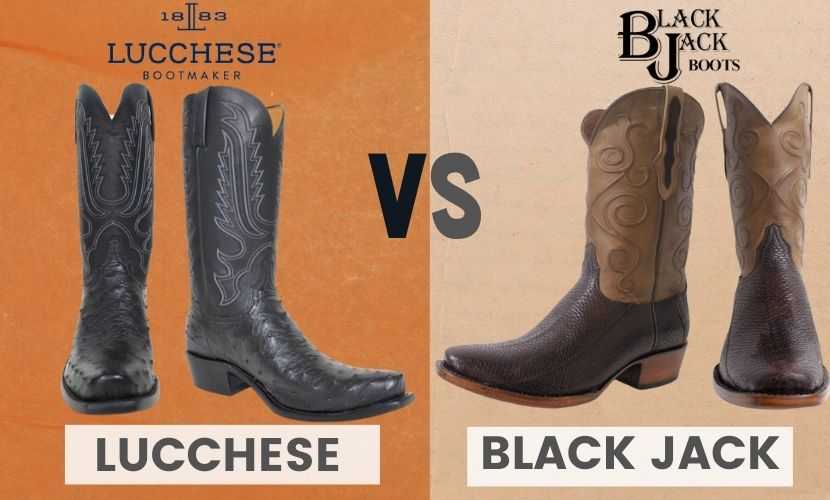Discovering the correct size and fit for purchasing shoes is critical for ease and performance. Hoka is a famous brand with broad and regular-sized shoes to lodge different foot appearances and sizes. But what is the dissimilarity between Hoka wide and regular shoes, and how do you select the right size for your feet?
Comprehending shoe widths is necessary when shopping for shoes. The width of a shoe consults the quantity of space between the foot and the shoe’s upper, and it can differ from tight to additional comprehensive. Hoka features both extensive and regular widths, having the broad choice offering more space in the forefoot and midfoot areas.
However, it’s obligatory to mention that not all Hoka shoe designs are available in both width choices.
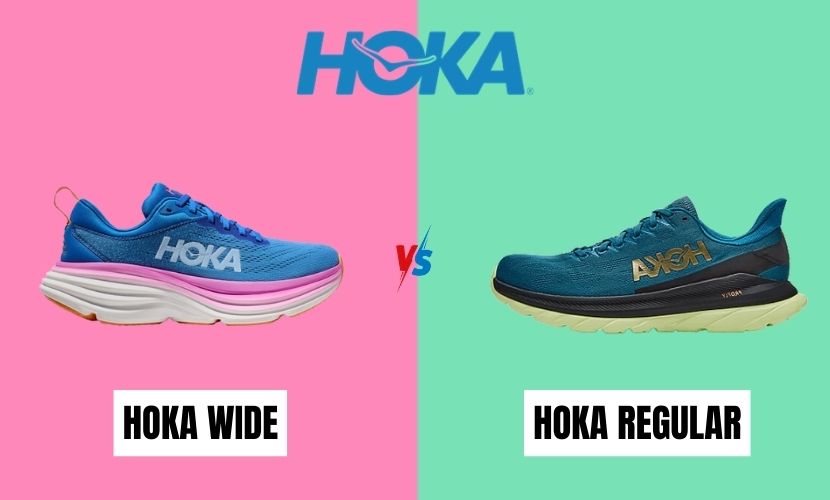
Comparison Table: Hoka Wide Shoes Vs Hoka Regular Shoes
| Feature | Hoka Wide Shoes | Hoka Regular Shoes |
| Width Options | Wide (EE) for men, Wide (D) for women | Regular (D) for men, Regular (B) for women |
| Fit and Comfort | More space in the forefoot area, suitable for wider feet. | Snug fit, ideal for standard or narrow feet. |
| Performance | Similar performance regardless of size; depends on shoe design. | Performance consistent across all sizes, determined by shoe construction. |
| Price | Cost is the same for both wide and regular sizes; depends on shoe model. | Shoe price unaffected by size; choose based on fit. |
| Choosing the Right Size | Measure feet, consider width, and consult size chart for guidance. | Measure feet accurately, consider width, and refer to the size chart. |
| Benefits of Width | Enhanced comfort for wider feet; reduced discomfort and better fit. | Snug fit for standard or narrow feet; stability. |
| Width Indications (B vs. D) | B (women’s) is medium width; D (men’s) is moderate width. | B (women’s) is medium width; D (men’s) is moderate width. |
| Verification of Width | Check shoe label for width designation; assess wear patterns; try different sizes. | Confirm width on shoe label; analyze wear patterns; try various sizes. |
Key Takeaways
- Hoka features broad and regular-sized shoes to make room for distinct foot appearances and sizes.
- Extensive shoes offer more space in the forefoot and midfoot sections.
- Choosing the right size and width for your feet ensures comfort and performance.
Understanding Shoe Widths
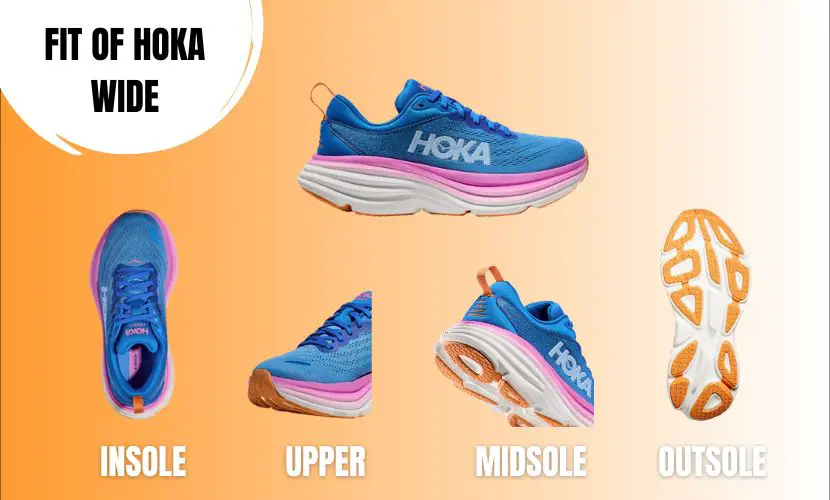
Shoe sizes are not just detected by length but also by width. Width is an obligatory factor to contemplate when buying shoes, particularly for people with broader or tighter feet. Like most shoe brands, Hoka utilizes an amalgamation of length and width to detect shoe sizes.
Hoka features shoes in two widths – regular (D) and wide (EE). The standard width is adaptable for people with normal or moderately extensive feet; however, the wide width is structured for people with vast feet. The width of a shoe can differ based on the brand and style, so it is essential to test the shoes before buying them.
To detect whether a shoe fits appropriately, one should contemplate the length and width of the shoe. The toes should have enough space to wiggle, and the shoe should not be too narrow or loose. A shoe that is too tight can lead to discomfort; on the contrary, a shoe that is too loose can cause injuries and other foot issues.
When buying Hoka shoes, it is suggested to compute both the length and width of the feet to verify an appropriate fit. Hoka features a size chart and sizing information on its website to help users discover the perfect size.
In summary, comprehending shoe widths is necessary when buying shoes. Hoka features shoes in standard and wide widths to lodge different foot sizes. It is obligatory to test shoes before buying them and to compute the length and width of the feet to verify an appropriate fit.
What is the difference between Hoka wide and regular shoes?
Hoka shoes are famous for their versatile pattern and superior padding, making them a renowned option among players and athletes. Regarding selecting the perfect Hoka shoe, it is necessary to consider the width of the shoe. Hoka features both broad and average sizes, but what is the difference?
Width
The primary difference between Hoka extensive and regular shoes is the width of the shoe. Hoka wide shoes contain a wider forefoot area, offering more space for the toes to move voluntarily.
Conversely, regular Hoka shoes comprise a tighter forefoot area, giving a comfy fit.
Comfort
Selecting the ideal width is critical for achieving moderate comfort. If you have extensive feet, opting for a regular Hoka shoe can lead to discomfort and even cause foot issues.
Similarly, if you have tight feet, selecting a broad Hoka shoe can cause the shoe to skid and slide around, leading to discomfort and injuries.
Sizing
Hoka wide shoes are accessible in both men’s and women’s sizes, extending from 2E to 4E for men and D to 2E for women. Normal Hoka shoes are obtainable in regular sizes for men and women, varying from D to 2E for men and B to D for women.
In summary, the essential dissimilarity between Hoka wide and regular shoes is the width of the shoe. Selecting the perfect width is critical for attaining optimal ease and averting foot issues. Hoka features many sizes for both broad and regular shoes, verifying that you can discover the ideal fit for your feet.
Hoka Wide Shoes
Hoka One One is a well-admired brand with regular and extensive shoe sizes. Broad shoes are structured to give more space in the toe box and forefoot area, making them a perfect choice for people with wider feet or those who require more room because of swelling or other foot states.
Benefits of Hoka Wide Shoes
One of the chief advantages of Hoka wide shoes is that they offer more space in the forefoot area. This can aid in averting discomfort and pain, particularly for people with broader feet or those who tolerate conditions such as bunions or hammertoes. Furthermore, extensive shoes can help upgrade overall foot health by minimizing pressure points and permitting finer circulation.
Another advantage of Hoka-wide shoes is that they feature a more stable foundation. Wider shoes contain a greater surface area, supporting updating balance and minimising the possibility of ankle sprains or other blisters. This is mainly necessary for athletes or players who must adjust steadiness during top-impact activities.
Popular Hoka Wide Shoe Models
Hoka features a broad extent of shoes in both regular and extensive sizes. Several of the most renowned Hoka wide shoe designs include:
- Hoka Clifton 8 Wide: The Clifton 8 is a famous running shoe with regular and broad sizes. It offers a feathery pattern and a reactive padding system, making it a perfect choice for athletes of all levels.
- Hoka Bondi 7 Wide: The Bondi 7 is an incredibly padded shoe with remarkable aid and comfort. It is accessible in regular and wide sizes, making it an ideal choice for people with broader feet or requiring more room in the toe box.
- Hoka Arahi 5 Wide: The Arahi 5 is a steady shoe with regular and wide sizes. It provides an adaptive pattern and a padded midsole, making it a perfect choice for people suffering from overpronation or other foot conditions.
In conclusion, Hoka wide shoes are perfect for individuals with broader feet or requiring more space in the toe box. They offer many advantages, including advanced comfort, steadiness, and foot health. Many models have a Hoka-wide shoe for each activity and foot kind.
Hoka Regular Shoes
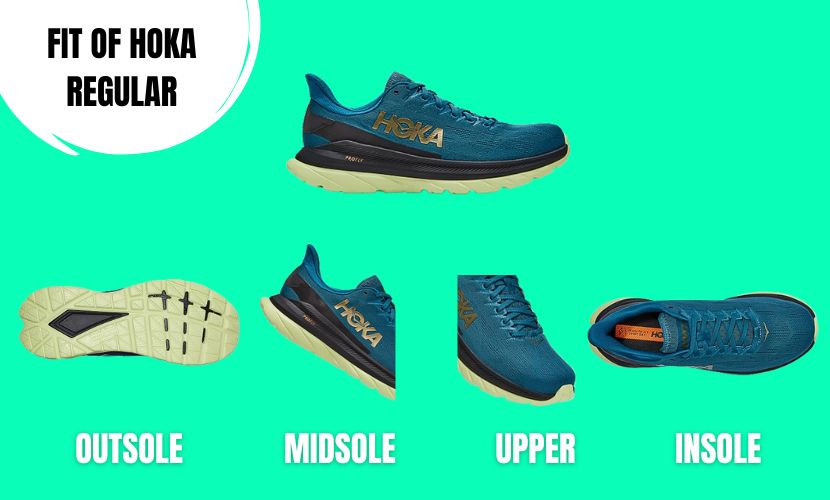
Hoka regular shoes are engineered for players who do not require additional room in their footwear. These shoes are ideal for people who have average or narrow feet. This section will discuss the advantages of Hoka regular shoes and the top Hoka regular shoe patterns.
Advantages of Hoka Regular Shoes
Hoka regular shoes feature some advantages over their broad counterparts. Several advantages incorporate:
- Better fit: Hoka regular shoes fit comfortably around the foot, giving a more safe and snug fit.
- Improved stability: Regular shoes feature finer strength, particularly for athletes with tight feet. This is because they have a stricter base, which gives finer aid.
- Lighter weight: Hoka regular shoes are typically more feathery in weight than their extensive counterparts. This makes them perfect for runners who prioritize delicate shoes.
Top Hoka Regular Shoe Models
Hoka provides an extent of standard shoes for both men and women. Following are several significant Hoka regular shoe designs:
| Model | Description |
| Hoka One One Clifton 8 | The Clifton 8 is an iconic shoe that gives remarkable padding and aid. It is perfect for athletes who desire a delicate shoe for daily training. |
| Hoka One One Bondi 7 | The Bondi 7 is a famous shoe that features maximum padding and support. It is ideal for players who want a snug shoe for long-distance running. |
| Hoka One One Mach 4 | The Mach 4 is a reactive shoe that offers an even ride. It is ideal for runners who desire a fast shoe for racing and speedwork. |
Overall, Hoka regular shoes are a perfect option for runners who do not need extra space in their footwear. They feature a finer fit, advanced stability, and delicate weight, making them ideal for athletes with standard or tight feet.
Comparing Hoka Wide and Regular Sizes
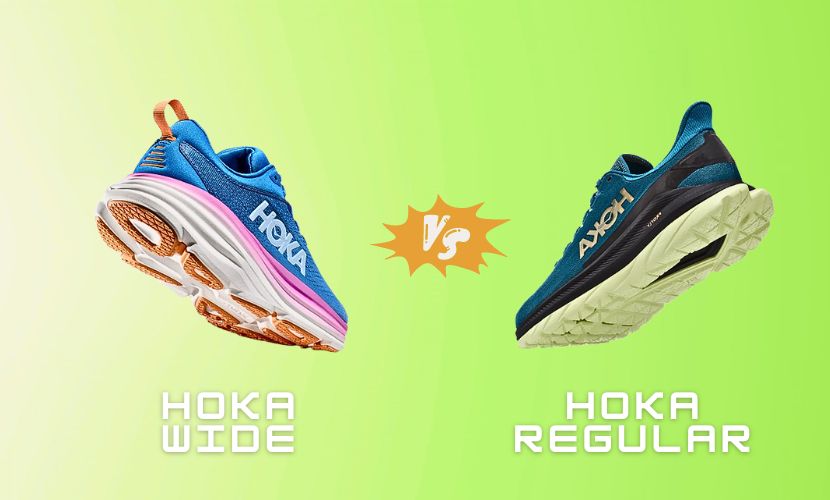
Fit and Comfort
Hoka features broad, ordinary-sized shoes to verify an ideal fit for everyone. The critical difference between the two sizes is the width of the shoe. Hoka wide shoes contain a wider forefoot area with the same midsole space, giving more room for the toes to wiggle. On the other side, regular-sized shoes are structured for those who do not have broad feet, plantar fasciitis, or smooth feet.
Concerning comfort, both broad and typical sizes are equally snug as long as they fit the person’s foot appearance and size. Testing on both sizes and walking around to detect which size feels more snug is necessary.
Performance
The performance of Hoka wide and regular-sized shoes is similar. The dissimilarity in size does not influence the performance of the shoe. The shoe’s performance inclines on its pattern, materials, and technology utilized in its formation, consistent across all sizes.
Price
Hoka wide and regular-sized shoes cost the same. The shoe price depends on the model and technology utilized in its formation, not the size. Therefore, people can select the size that fits them perfectly without worrying about the cost.
In conclusion, concerning Hoka wide vs. regular sizes, the selection depends on individual preference, foot appearance, and size. Individuals with broad feet, plantar fasciitis, or flat feet should wear Hoka-wide shoes; however, those with regular feet should select regular-sized shoes. Both sizes are equally snug and function the same, and the cost is the same for both sizes.
How to Choose the Right Hoka Size
Regarding selecting the right Hoka size, it’s obligatory to consider the width of your feet. Hoka features regular and wide measures to verify a snug fit for everyone. Following are several tips to aid you in selecting the right Hoka size.
Measure Your Feet
The initial step in selecting the perfect Hoka size is to compute your feet. You can perform this by tracing the outline of every foot on a piece of paper and adding the length from the heel to the longest toe. Contrast your foot length to the Hoka size chart to detect your size.
Consider Your Foot Width
If you have broad feet, it’s necessary to select the ideal width when choosing your Hoka size. Hoka provides both regular and wide lengths, so verify to check the width table to detect which size is perfect for you.
Try Them On
Once you have detected your Hoka size, testing them to certify a snug fit is obligatory. Verify to wear the socks you intend to wear with your Hokas and walk around to attain a feel for the fit.
Final Thoughts
The perfect Hoka size is critical to verifying a snug and enjoyable running experience. You can discover your ideal Hoka size by computing your feet, considering your foot width, and testing them.
Is Hoka Wide Fit?
Hoka features shoes in two widths, regular (D) and wide (EE), to adapt to the requirements of a diversity of foot sizes and shapes. However, it is necessary to mention that not all Hoka shoes are accessible in wide sizes.
The width of Hoka shoes is specified by a letter next to the shoe size. A premium width Hoka shoe for women is designated by the letter “B,” on the contrary, a wide width is indicated by the letter “D.” For men, a premium width is shown by the letter “D.” In contrast, a wide width is stipulated by the letter “2E.”
Verifying that the shoe fits appropriately is obligatory to avoid discomfort or blisters. When testing on Hoka shoes, wearing the socks that will be used during exercise and checking on shoes at the end of the day when feet are most swollen is suggested.
In contribution to width, Hoka shoes also provide a diversity of attributes to intensify ease and performance. These characteristics incorporate a padded midsole, a rocker sole pattern, and a delicate construction. Hoka shoes are constructed for players and athletes who desire to upgrade their performance while lessening the possibility of injury.
Overall, Hoka shoes are perfect for individuals with broader feet requiring additional space. However, it is necessary to verify that the shoe fits appropriately and select an ideal shoe for the intended activity.
How Do I Know If My Hoka Shoes Are Wide?
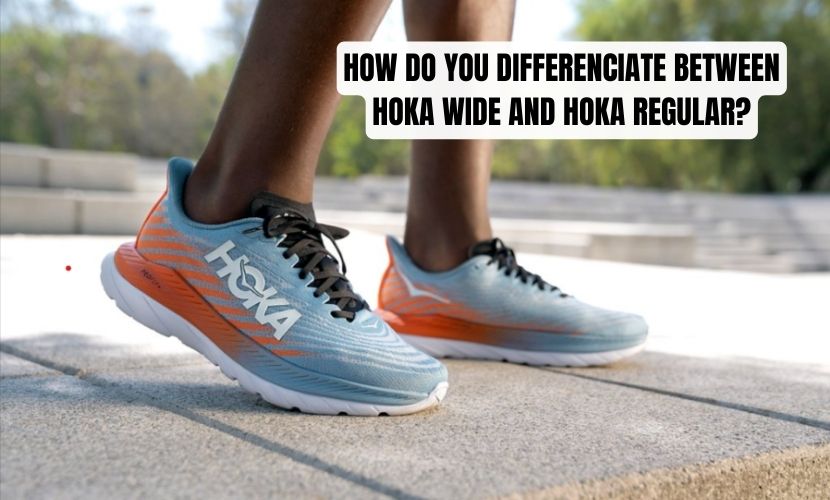
Hoka shoes are famous for their snug and adaptive fit. However, getting the perfect size and width is critical to verify maximum ease and performance. Following are several tips to aid you in detecting if your Hoka shoes are wide.
Check the Width Indication
Hoka shoes are available in both ordinary and wide widths. The width of the shoe is designated by a letter after the shoe size. For men’s shoes, a “2E” is wide; conversely, a “D” indicates a regular width.
For women’s shoes, “D” indicates a premium width, while “B” shows a tight width and “2E” reveals a wide width.
Look at the Wear Pattern
Another way to detect if your Hoka shoes are too tight is to look at the wear design on the shoes. If the wear is vigorous on the edges of the shoes, it may show that they are too tight.
In comparison, if the wear is concentrated on the outer sides of the shoes, it may indicate that the boots are too broad.
Try on a Pair of Wide Shoes
If you are still determining whether your Hoka shoes are broad enough, test them on a pair of wide shoes. This will allow you to contrast the fit and comfort of the wide shoes with your latest ones.
If the wide shoes feel more snug and adaptive, you may be required to switch to wide shoes.
Follow the Hoka Size Chart
Following the Hoka size table is necessary to verify that you have attained the perfect size and width of Hoka shoes. This chart calculates foot length and corresponding shoe sizes for both genders. Furthermore, the chart shows which sizes are accessible in standard and wide widths.
In conclusion, detecting whether your Hoka shoes are broad is necessary for getting the perfect fit and extra comfort. By testing the width indication, glancing at the wear design, testing on a pair of wide shoes, and following the Hoka size table, you can certify that you attain the ideal size and width for your feet.
HOKA width B vs. D: What do they mean?
HOKA shoes are available in distinct widths to lodge different foot kinds and sizes. The two most ordinary widths are B and D. Comprehending the dissimilarity between the two can aid you in selecting the perfect size and fit for your feet.
B Width
B width is the premium width for women’s shoes. It is also popular as a medium width. A B width may be too broad if you have a tight foot. Conversely, a B width may be too close if you contain a wider foot.
It is necessary to mention that not all brands utilize similar width computations, so it is always perfect to test on shoes before buying them.
D Width
D width is the premium width for men’s shoes. It is also renowned as a moderate width. A D width may be too broad if you have a tight foot. On the other hand, a D width may be too close if you have an extensive foot.
Typically, a wider shoe features more space for the toes and the ball of the foot, which can be advantageous for people with wider feet or those who require orthotics or braces. However, a shoe that is too broad can lead the foot to slide inside the shoe, which can cause blisters and other foot issues.
When selecting between a B and D width, it is obligatory to consider the appearance and size of your foot and the activities you will be performing in the shoes. It is always perfect to test on distinct lengths and widths to discover the ideal fit for your feet.
What are the Benefits of Wearing Hoka Wide Shoes?
Hoka One One is a renowned running shoe brand with various shoes for various foot kinds. One of the most efficient advantages of wearing Hoka-wide shoes is that they offer more space for people with broader feet. Following are several other advantages of wearing Hoka wide shoes:
1. Enhanced Comfort
Wearing perfectly fit shoes is essential for comfort, particularly when running or walking for elongated periods. Hoka wide shoes offer additional room in the forefoot, which aids in averting rubbing and blisters.
They also contain a broader platform, which features more steadiness and aid.
2. Improved Performance
Wearing the perfect shoes can upgrade performance by giving finer support and ease.
Hoka wide shoes feature a more sturdy base, which can aid in boosting balance and minimize the possibility of injury. They also contain a massive midsole, which can soak up the impact and offer finer padding.
3. Reduced Discomfort
People with broader feet often experience discomfort when using shoes that are too tight. Hoka wide shoes offer more space, which can lessen discomfort and pain.
They also contain an extensive toe box, which permits toes to spread out and move innately.
4. Better Fit
Wearing shoes that fit ideally is obligatory for overall foot health. Hoka wide shoes feature a finer fit for people with wider feet, which can aid in averting foot issues such as bunions, corns, and calluses. They also contain a more snug fit, which can minimize the possibility of blisters and other foot injuries.
In summary, Hoka wide shoes feature advanced comfort, upgraded performance, minimized discomfort, and a finer fit for people with wider feet. They are an outstanding option for runners and walkers who desire to boost their performance and avert foot issues.
Conclusion
Regarding selecting between Hoka wide vs. regular shoes, it all depends on individual preference and fit. Both choices have advantages and disadvantages, and it’s up to the person to select which is perfect.
The Hoka wide shoes may be superior for those with broader feet or who prioritize a spacious fit. Conversely, those with tighter feet or who agree on a more comfortable fit may discover the regular-sized Hoka shoes to be a finer fit.
It’s necessary to mention that Hoka features both wide and regular sizes for most of their shoe designs, so it’s worth testing both choices to detect which one feels more snug and adaptive.
Eventually, the key to discovering the ideal Hoka shoe is to prefer fit and ease over anything else. With the perfect fit, both Hoka wide and regular shoes can feature the aid and padding needed for a snug and delightful running or walking experience.
Read more on:



